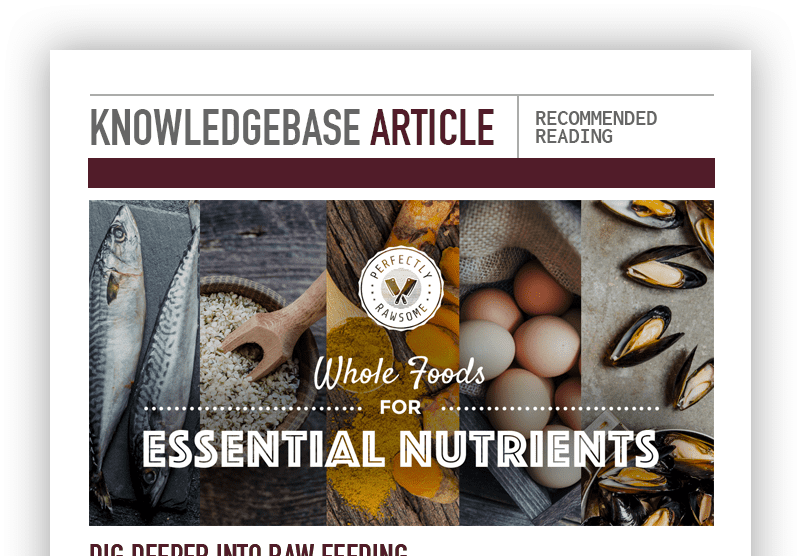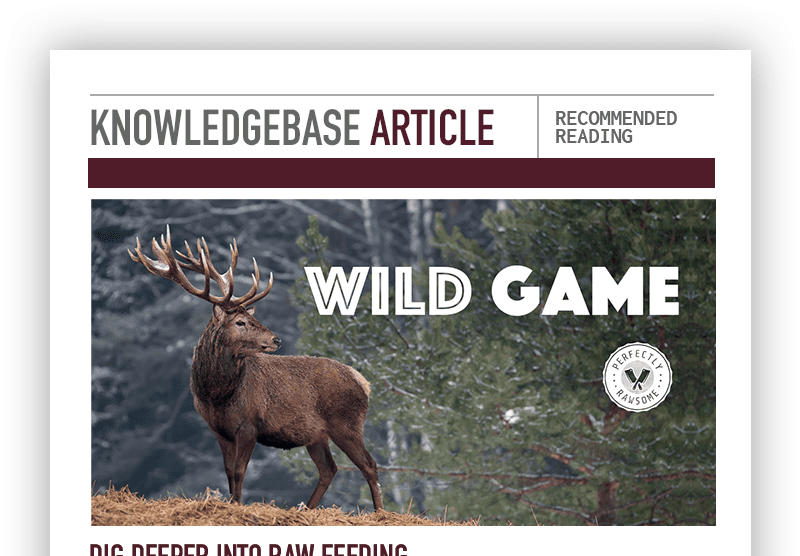Raw diets are often compared to the natural diet a wild dog or cat would consume. Whole prey is defined as a small prey animal that a wild dog or cat can physically hunt, catch, kill, and consume. Consumption of a small prey animal includes all of the organs, skin, head, and fur or feathers with very minimal remains.
Whole prey is taboo for many pet parents who are sensitive to viewing dispatched whole prey animals. However, it is important to know that whole prey is not required in order to feed a balanced fresh food diet if the pet parent is not comfortable with the concept. While there are many benefits to feeding small whole prey, there are also some drawbacks to consider.
Types of Whole Prey
There is a common misconception that all whole prey is nutritionally balanced. However, it’s important to consider the differences between domestic and wild prey.
Whole Prey Nutritional Content Variables
There are five variables that contribute to the nutritional content found within whole prey. These include species type, soil mineral depletion, diet consumed, sun exposure, daily exercise, harvesting and storage method.
Benefits of Whole Prey
Whole prey also provides enrichment opportunities to dogs and cats in addition to nourishment.
Drawbacks of Whole prey
There are several drawbacks to consider when choosing to feed whole prey to a dog or cat.
Feeding Whole Prey
The introduction of whole prey can be easy for some pets. Although there may be occurrences where a slower introduction is necessary.
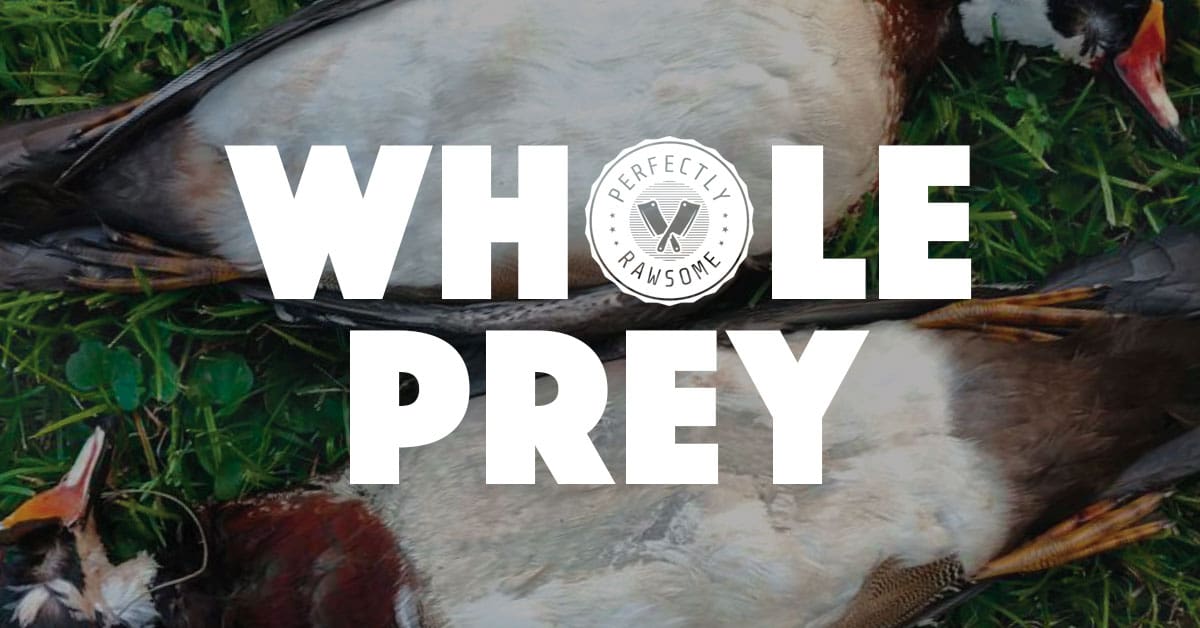
Types of Whole Prey
Feeding whole prey is often viewed as the gold standard of fresh feeding among many raw pet food circles because it is considered the most “natural”. However, there are two main categories of whole prey which includes farmed domesticated prey animals and wild prey animals.
Farmed Whole Prey – Domesticated Species
The most common whole prey available is domesticated species that are raised in farming conditions. These options are commonly used to feed falcons, reptiles, and other large predatory animals living in captivity. Farmed whole prey animals include:
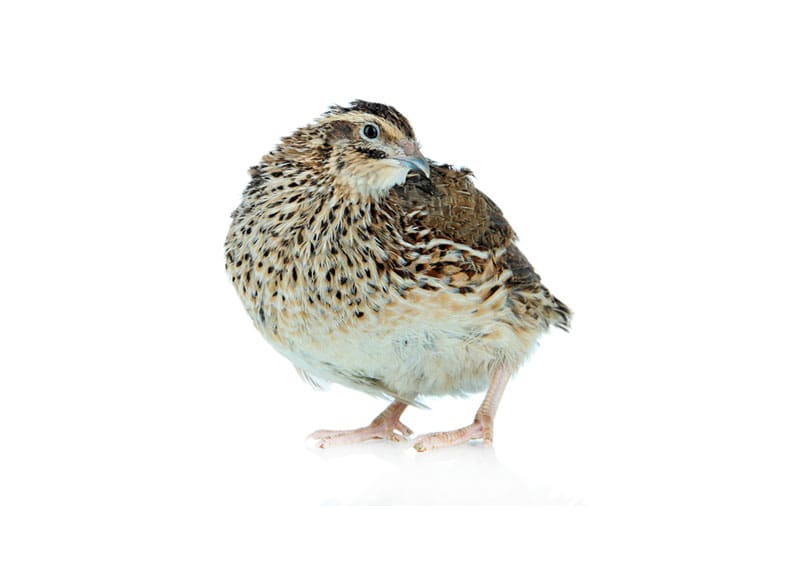
Quail

Cornish Hen & Chicken
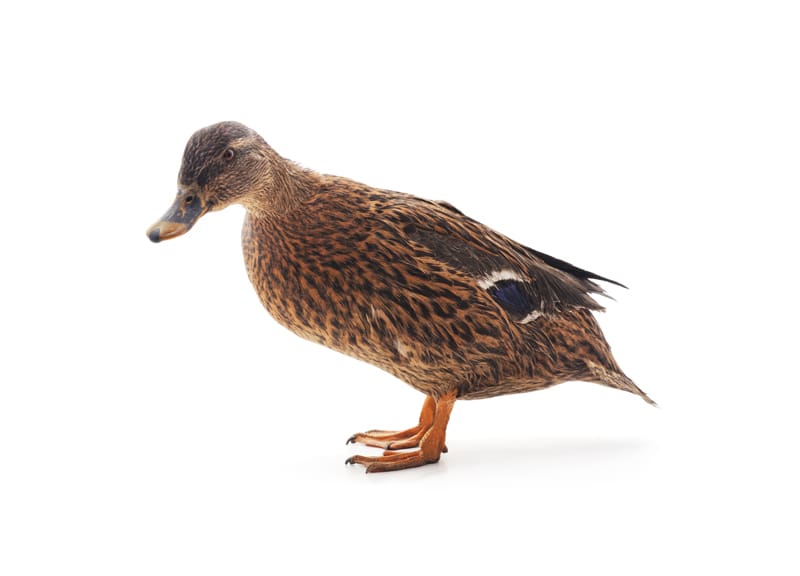
Duck
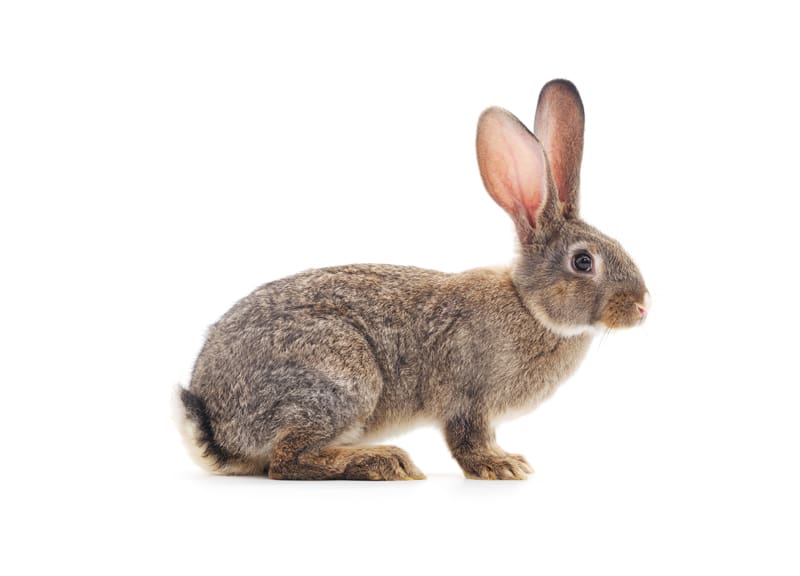
Rabbit

Mice

Rats
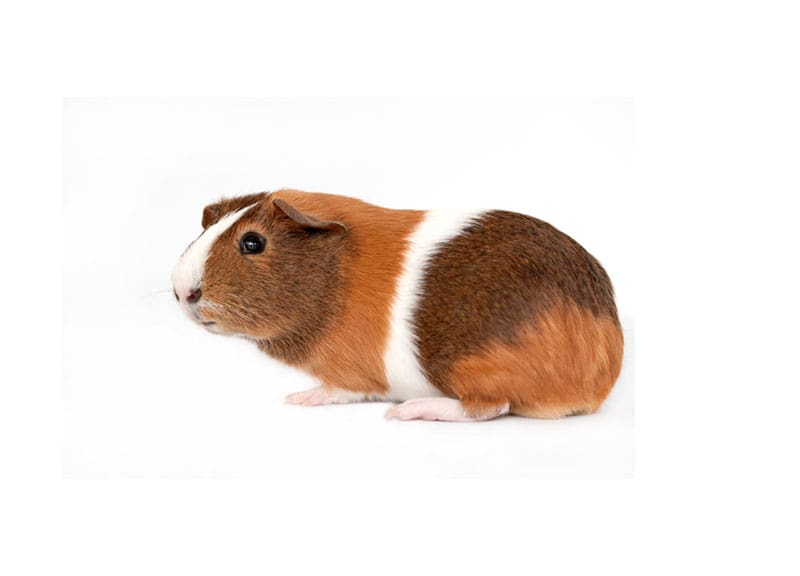
Guinea Pigs
Wild Whole Prey – Wild Species
It is uncommon for most pet parents to have consistent access to wild whole prey animals unless they hunt, trap or have connections with hunters. However, there are many wild whole prey species that can be incorporated into a raw diet if the resources are available. Wild whole prey animals include:

Quail

Pheasant
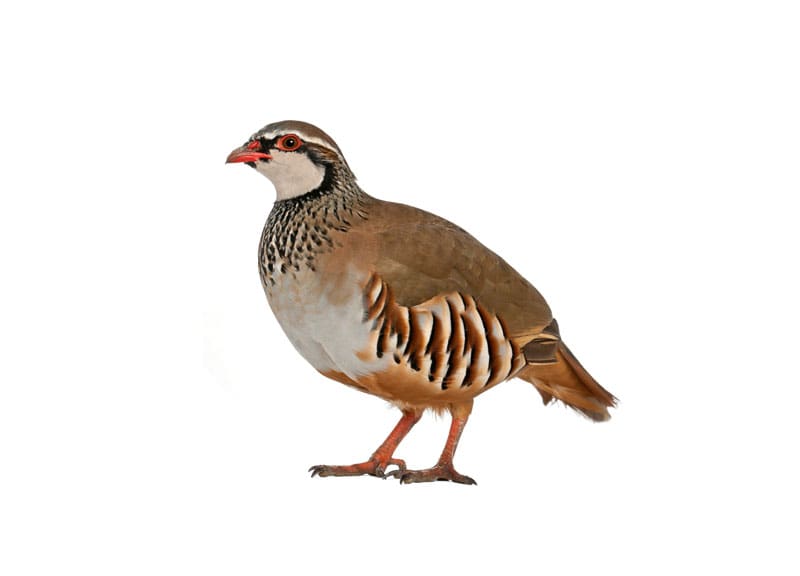
Chukar

Duck

Goose

Rabbit

Squirrel
Whole Prey Nutritional Content Variables
Whole prey refers to the entire animal. This includes the skin, feathers/fur, organs, glands, blood, and intestinal tract which is not found in raw meat sold for human consumption at a supermarket or butcher. There are many variables that play a role in the nutritional content of whole prey and how that fulfills a dog and cat’s individual requirements for essential nutrients. Therefore, feeding a diet entirely of whole prey may or may not provide a well balanced diet. Factors that affect the nutritional content of prey animals include:
Species & Type
It is often assumed that all whole prey is nutritionally complete. However, different species of prey will vary in their nutritional content. A diet consisting of only one prey species is highly likely to contain nutrient deficiencies, especially if the prey is domestically raised.
In addition to different prey species containing varying nutrient profiles, the nutritional content of whole prey will differ greatly between domestically raised and wild prey.
The Diet Consumed
A wild animal will typically consume a very different diet in comparison to domestically farmed animals of the same species. Even domestically raised animals can vary in their diet depending on what is provided to them. Diet types of prey animals can include grain fed and finished; grass fed and grain finished; grass fed and finished; and wild prey diets.
Grain fed and finished refers to farmed meat animals that have been fed a commercial grain-based animal feed throughout their lifespan up until the time they are ready to be processed for food.
Grass fed and grain finished refers to farmed meat animals that have been pasture raised and/or provided a grass-based feed such as hay. The animals are then “finished” by feeding a grain-based feed temporarily before the animal is processed for food.
Grass fed and finished refers to farmed meat animals that have been pasture raised and/or provided a grass-based feed such as hay for their entire lifespan up until the time they are ready to be processed for food.
Wild prey will consume what is available to them within their dietary limitations. This may or may not be an adequate diet depending on the season and what is available in the area. However, wild prey generally consume a natural diet which consists of grasses, shrubs, wild herbs, twigs, nuts, seeds, and berries.
Sun Exposure
Whether a prey animal is wild, pasture raised, or raised indoors will also affect their nutritional content through the differences in sun exposure and environment. For example, a pigs body can produce Vitamin D through sun exposure. Pork will have a greater concentration of Vitamin D within the fat if the animals are raised with access to sun exposure as compared to pigs raised completely indoors.
Exercise Frequency
A major factor that contributes to the difference between domestic and wild prey is the prey animal’s diet and their activity level. A prey animal’s diet and activity level have a direct impact on the nutritional content of their muscles, organs, glands and bones. In general, these differences result in prey animals being red meat if they are wild, and white meat if they are domestic.
The classification of white and red meat are based on the type of fibers muscle tissue is made of. There are fast twitch (white meat) and slow twitch (red meat) muscle fibers. White meat is lighter due to low concentrations of myoglobin in the muscle tissue because fast twitch fibers do not require oxygen to produce energy for muscle contractions. Red meat is darker due to higher amounts of myoglobin present in the muscle tissue because slow twitch fibers require a rich supply of oxygenated blood to produce sufficient energy for prolonged muscle contractions. Red meats are generally higher in protein, B vitamins, and minerals than white meats.
Fat Levels
All wild game is much lower in fat and higher in minerals like zinc and iron than farm raised animals. Additionally, the essential fatty acids found in wild game are balanced in comparison to most commercially farmed meats. These differences happen in all prey animals regardless of the species and are important factors that differentiate them from their domesticated counterparts.
Harvesting & Storage Method
Nutritional content within whole prey is affected by how the animal is harvested after dispatch and stored before feeding. It is a common practice for humans to bleed-out animals before harvesting the individual parts of the animal for consumption. This is unnecessary when feeding whole prey to a dog or cat because the bleed-out process reduces the total nutritional content of the whole prey itself.
Freezing conditions will have an effect on the nutritional content of the prey but the outer skin, fur or feathers serve as a protective layer against freezer burn and major nutritional loss. This does not eliminate the potential if the prey remains in the freezer for a prolonged period of time.
Due to the many variables affecting the nutritional content of whole prey and the incomplete nutritional data on whole prey, it is recommended to rotate domesticated whole prey with other balanced feeding methods. Pet parents can feed domesticated whole prey 1x a week in rotation with other complete and balanced pet foods without sacrificing essential nutrients. However, the frequency of wild whole prey can be increased if the fat levels are accounted for.
Benefits of Whole Prey
Raw meat, bones, and organs for human consumption have gone through the production and inspection process to adhere to the regulatory guidelines for resale. This means the skin, fur/feathers, glands, intestinal tract, and blood is removed from all prey animals in preparation for sale and human consumption. In this process, many valuable nutrients are removed along with these items as well.
Natural Dietary Fiber
Fiber is important for gut health, aids in digestion, stool regularity, weight management, blood sugar regulation, and more. Traditional PMR ratio guidelines for dogs and cats fail to include fibrous foods, which is present when feeding whole prey. Therefore, whole prey or animal parts that include fur or feathers are beneficial to include in a fresh food diet.
Fur and feathers from whole prey are a source of animal-based fiber in homemade diets that do not include vegetables. Fur and feathers provide insoluble fiber which resists water absorption in the colon and cannot be enzymatically digested. Therefore, insoluble fiber passes through the initial stages of digestion and ferments in the colon where it increases fecal bulk. The increase in fecal bulk is beneficial for correcting constipation, regulating stool frequency, and expressing anal glands.
It is important not to overfeed fiber. Too much fiber can result in choking, gas, constipation, or obstruction. It is recommended to avoid feeding wool or large quantities of only fur or feathers.
Nutrient Variety
The inclusion of all internal organs, glands, and blood in whole prey provides a higher concentration of vitamins and minerals in comparison to plain muscle meat. “Frankenprey” ratio diets that utilize a combination of store bought meat, bones and organs will not include certain body parts that are removed when processing an animal for human consumption.
Head & Eyes
Whole prey includes the head and eyes of a prey animal which may or may not be available for purchase for ratio diets. Eyeballs may contain a decent amount of zinc, while the brain is a source of DHA.
Blood
The blood found within whole prey is a rich source of iron. Whole prey raised for human consumption are typically bled-out and will have lower levels of iron in comparison to whole prey that is not bled-out.
Mental & Physical Enrichment
Whole prey provides more than nourishment alone. It also enriches the mind and allows pets to express their species and breed tendencies in a controlled and safe way. Dogs and cats are predatory animals and can receive mental enrichment benefits from consuming whole prey. Whole prey provides the opportunity for dogs and cats to engage in their instinctual eating behaviors of shredding and chewing on an animal carcass. This can never be achieved by feeding individual cuts in a bowl. These behaviors have a profound change on a dog’s and cat’s mental enrichment. It increases serotonin and oxytocin in the brain which are known as the “feel-good” hormones.
Drawbacks of Whole Prey
There are several potential drawbacks that should be considered when choosing to feed whole prey. Many pet parents make the mistake of assuming that any whole prey is automatically a complete and balanced diet. This assumption comes from the premise that wild canines and felines survive off of whole prey animals. However, wild carnivores often experience nutrient deficiencies and starvation due to lack of ideal food choices and unfavorable conditions.
Domestic dogs and cats can live longer and healthier lives in captivity due to the protection and care they receive from their human caretakers. While the natural diet of wild dogs and cats can be a starting point for a healthy diet, providing optimal nutrition requires careful consideration.
Difficulty Sourcing
Whole prey can be difficult to source because it is not sold in grocery stores. Domestic whole prey can be sourced from local farmers, raw pet food suppliers, and companies that supply feeder prey for reptiles. Pet parents may also choose to raise whole prey animals such as rabbits or quail at home. Wild prey may be obtained by hunting or trapping while adhering to the laws and hunting regulations in their state.
Personal Boundaries
Many pet parents choose to avoid feeding whole prey because they have personal boundaries on handling whole prey and observing their pet consume it. Additionally, when raising meat animals within a home setting, the pet parent(s) must face the task of dispatching the animal.
Picky Pets
Some pets do not take to eating whole prey right away, or they refuse to eat it entirely. The pet parent may need to slowly introduce the whole prey to teach the pet that the whole prey can be consumed. This can be accomplished in two methods.
Nutrient Deficiencies
Many pet parents make the mistake of assuming that any whole prey is automatically a complete and balanced diet. However, it is important to consider that many factors play a role in the nutritional content of whole prey. These nutrient deficiencies need to be considered when feeding a large volume of whole prey in a diet to a dog or cat.
Many of the nutrients lacking in ratio based diets are also lacking in whole prey which include ALA, EPA, DHA, Vitamin D, Vitamin E, Zinc, Manganese, and Iodine.
Parasites
Wild caught whole prey carries the additional risk of potential parasites and pathogens. Wild prey should be frozen for a minimum of 3 weeks before feeding. Additionally, it is recommended to visually check the prey and the liver for parasites.
Removing the intestinal tract before freezing may be prudent. It is important to research and be aware of any known diseases that prey in a particular area may carry. In addition to this, wild rodents should be avoided due to the potential of these animals to have ingested poison.
Feeding Whole Prey
Many pet parents have questions on how to portion and feed whole prey. Whole prey can be treated as a partial or entire meal with little to no prep necessary.
It is important to note that all feeding recommendations are based on feeding whole prey that has been humanely dispatched or acquired through hunting. Live prey feeding is unethical and unsafe – these guidelines are not intended to promote or encourage feeding live prey animals to dogs or cats in any way.
Select Appropriate Whole Prey
It is helpful to choose whole prey that is an appropriate size for the pet. Examples can include but are not limited to:
Cats & Small Breed Dogs
Young Quail
Rabbit Pinkies
Day Old Chicks
Feeder Mice
Medium & Large Breed Dogs
Mature Quail
Young Rabbit
Cornish Hen
Young Feeder Rats
Large & Giant Breed Dogs
Mature Rabbit
Cornish Hen
Mature Feeder Rats
Guinea Pigs
Introduce Whole Prey
An introduction to whole prey is not necessary if the dog or cat naturally accepts the item. However, there are three ways to introduce whole prey to pets who are hesitant to consume whole prey. This includes feeding a whole prey grind; gradually increasing prey size over time; and removing some or all of the skin, fur or feathers.
Whole prey grinds include the whole animal and can be used to introduce a dog or cat to whole prey meals because the grind will have a different smell and texture in comparison to the same protein cut into individual pieces. There are a few pet food retailers in the US that sell whole prey grinds.
Top Quality Dog Food
Ground Whole Prey Rabbit
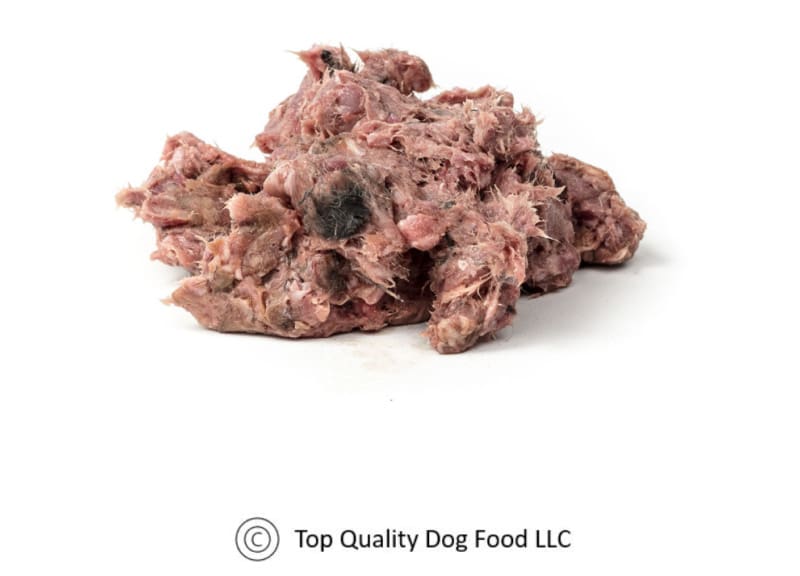
Another introduction method involves feeding very small whole prey such as Day Old Chicks (DOCs) because they are often small enough to mix into other food or cover with bone broth to encourage consumption.
The final introduction method involves cutting open or partially removing the skin to encourage the pet to eat the item. Alternatively, the prey may need to be fully skinned at first in order for the pet to accept it. Once the skinned prey item is being consumed, the amount of skin, fur or feathers left on the prey can be gradually increased over time. However, some pets may never accept whole prey regardless of the introduction process.
Whole Prey Meal Options
If a whole prey item is smaller than the pet’s normal daily meal weight, the prey can be combined with a reduced portion of balanced homemade or premade fresh food. If a pet normally eats 16 ounces (454g) of home prepared raw per day, then a 16oz (454g) whole prey item can be fed as a meal. Pet parents who wish to raise their own whole prey can choose to dispatch larger prey when it reaches the appropriate size before it has fully grown.
Whole prey will not increase a dog’s or cat’s desire to hunt live prey. Many pet parents worry that feeding whole prey will increase their pet’s to desire to hunt other small pets as prey. However, the diet a dog or cat consumes does not dictate the instinct to stalk, chase, catch, kill, and consume prey animals. This instinct is driven by genetics and is only reinforced if the dog or cat is allowed to actively participate in the full hunting sequence.
Can Raw Feeding Make My Pet Aggressive?
CLOSING COMMENTS
There are multiple factors and benefits to consider when feeding whole prey to a dog or cat. Therefore, feeding a diet entirely of whole prey may or may not provide a well balanced diet. It is recommended to rotate whole prey with other balanced feeding methods.
Types of Whole Prey
There are many varieties of whole prey but they are all unique and differ from one another. It is important to know the difference between farmed whole prey and wild whole prey.
Whole Prey Nutritional Content Variables
The five variables that contribute to the nutrient content within whole prey need to be considered when feeding whole prey to a dog or cat.
Benefits of Whole Prey
Natural animal-based insoluble fiber, nutrient variety from off-cuts, and mental enrichment opportunities are the major benefits pets receive when consuming whole prey.
Drawbacks of Whole Prey
Sourcing, expenses, personal boundaries, picky eating behavior, and nutrient deficiencies are the pitfalls of whole prey but pet parents can overcome these roadblocks with the appropriate planning and selections.
Feeding Whole Prey
Feeding whole prey does not have to be complicated. However, it may take some encouragement for pickier pets to warm up to eating whole prey.
There are many ways to feed a balanced raw diet and there is no need to stick to one style. Whole prey can be rotated with other balanced diets such as Do-It-Yourself recipes, formulated recipes, or balanced premade raw pet foods.

